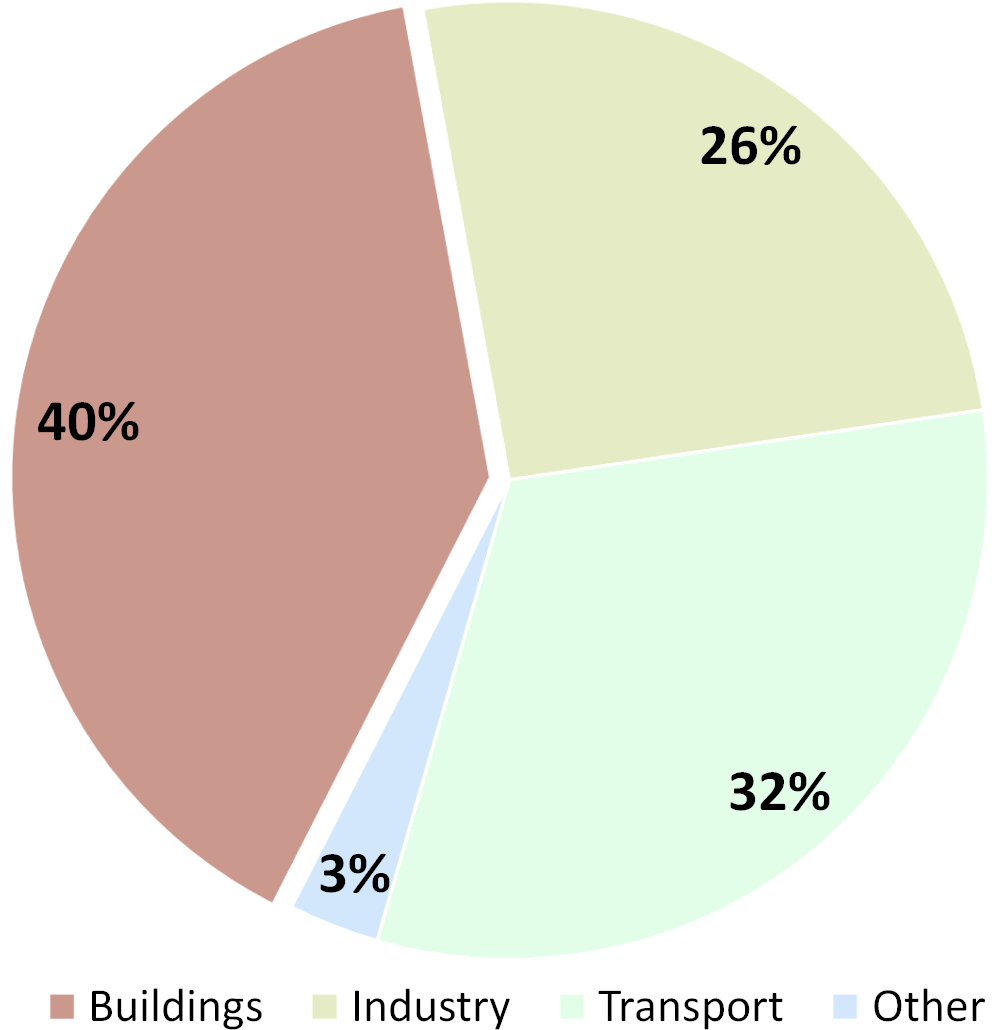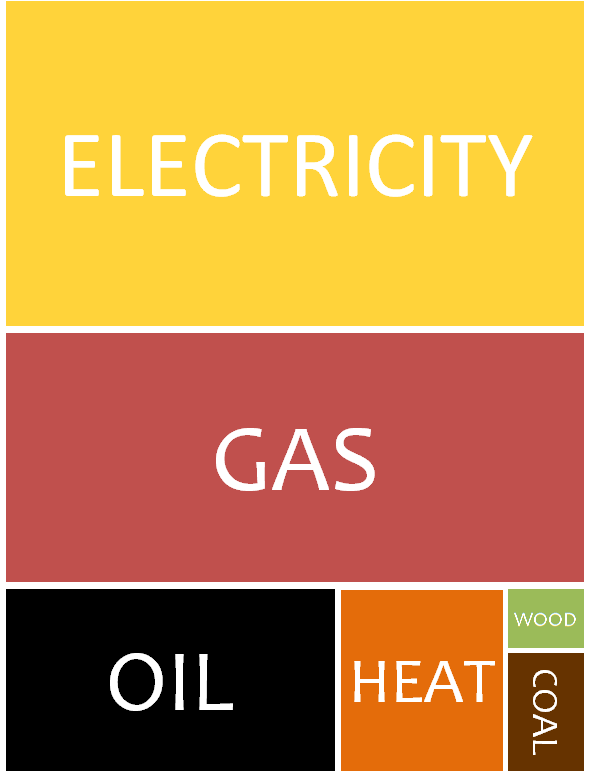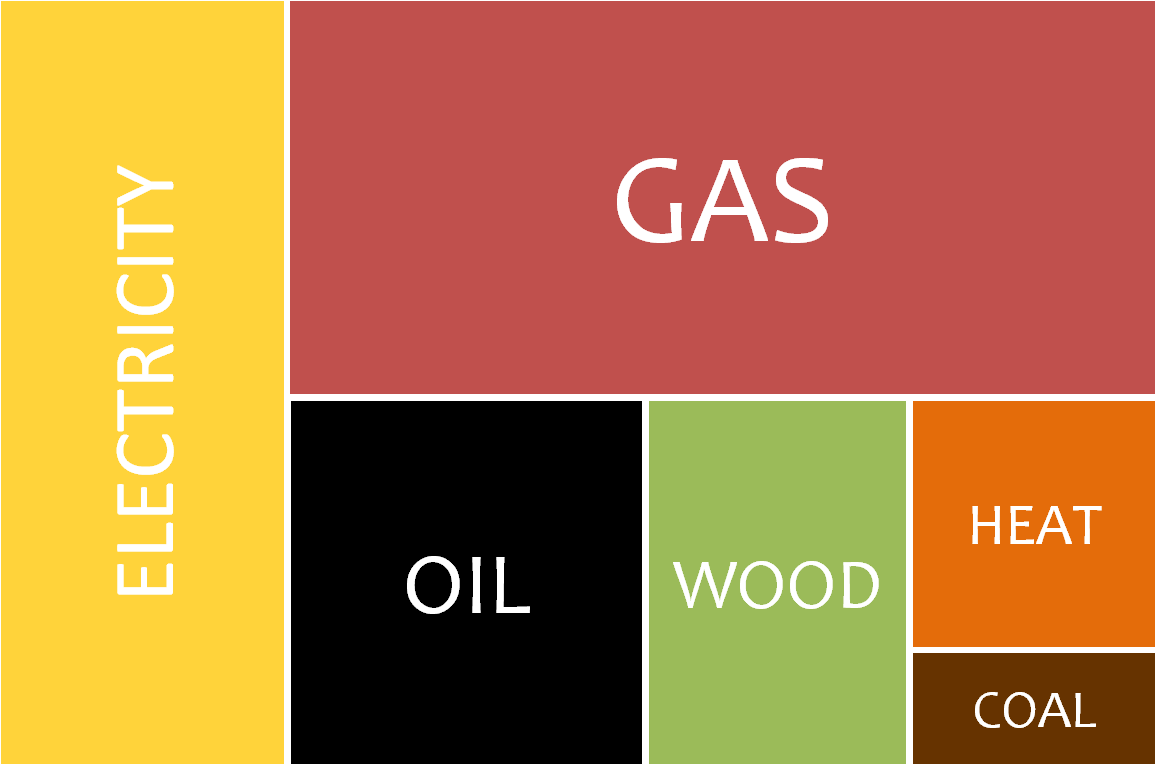The Case for ICT-services¶
Energy Efficiency – Buildings – Non-residential Buildings – Residential Buildings – The more insulation you have... – Barriers and obstacles – In-built upgrade potentials
Energy Efficiency¶
All influential organisations consider energy efficiency (EE) the cheapest and fastest option to limit greenhouse gas (GHG) emissions and global warming. It is not only the cheapest option for society as a whole but but also for stakeholders owning, operating and using buildings.
Energy efficiency in buildings is often synonymous for low-carbon construction, insulation and installing expensive hardware. This view is naive. Modern hardware does not always run smoothly - think of your laptop getting slower with time. Causes can be faulty set-ups, systems colliding or users making mistakes. Resolving these problems without stopping you from using the laptop can only be solved with immanently available information, automation and raising the user’s understanding.
Information and Communication Technologies (ICT) are capable of collecting data from various sources and flexibly provide the necessary paths and advice for a wide range of user types in any kind of building.
Whether deploying an EE service is financially feasible predominantly depends on whether consumption and operational savings outweigh the cost. To answer this question, heating and water should be considered as much as electricity to which smart metering is often reduced to.

Final energy consumption in the EU (2012)[1]
Buildings¶
In 2012, the 28 member states of the European Union consumed 1,103,410,100 tons of oil equivalent (TOE). Around 40% are consumed in buildings.
Note
Imagine the Niagara falls for 14 days and 3 hours, but with oil. This resembles the final energy consumption of buildings in the EU.
Investments into insulation and renovation take a long time to pay off. With ICT technology stakeholders can improve operational efficiency as much as EE today.
One immediate benefit of ICT is the detection of on-going wastage. In one example, energy services detected a heating system supplying 250 dwellings re-starting every 10 minutes. In another pilot a subcontractor had bodged the setup of a solar thermal plant reducing output by 30%. Before the projects, these instances had lead to inspections and unnecessary repairs further down the “pipe” which could have been avoided. Even if such “quick wins” are smaller in the majority of buildings, ICT can also help to increase performance at system level, reduce non-technical losses, and for remote reading and switching whilst providing a cheap platform for behavioural changes.
In order for buildings to provide their share in achieving the 20% energy efficiency target by 2020, the renovation rate of public buildings has to reach 3% every year.[2] Over the past years, this rate has not been reached and it is no wonder in times of economic crisis. ICT-enabled services allow payments by contracting future consumption savings and a the services are usually provided by SME. Surely, Energy Management Service (ems) and Energy Decision Support Service (edss) will not achieve immediate savings of 40% but they break even within a few years. Moreover, once the platform has been designed other buildings can be added to the system without much ado.
The Guide will differentiate between non-residential (e.g. public) and residential (e.g. social housing) buildings. Whether the user lives in the building or merely uses it has implications on consumption patterns, user attitudes and control as well as (dis)incentives resulting from regulation / law.
Non-residential Buildings¶
The public sector is to “lead by example” being a key element of today’s national and EU strategies for saving energy, and is mentioned explicitly in the ‘Energy Efficiency Directive’ (EED) adopted by the EU in 2012[3]. Buildings owned and/or managed by the public sector make up around 12% of overall EU building stock and spending of the public sector is 17% of EU GDP; around 40% of the construction turnover is public.[4]

Energy sources in non-residential buildings (EU)[5]
Irrespective of these figures a large share of municipalities have no sufficient policy for reducing operational cost of buildings. No doubt, the portfolio of buildings and resulting requirements are complex. At first sight, offices, schools and sports facilities do not have much in common. Yet they all have obvious usage patterns including off-times. Over the weekend or holidays, however, nobody is in the building able to detect wastage. Without smart-metering additional staff would have to be paid for to ensure optimised operation of buildings.
Another problem is responsibility. Staff does only occupy a small amount of space wishing for the best possible comfort within these boundaries. With or without rules, a compromise is found to make all staff affected as happy as possible. Does your office have a target temperature? With a target temperature there is a certain degree of accountability. Individuals cannot simply complain it to be too cold but many will - so possible - adjust temperature with thermostats, windows and other means.
Janitors and/or facility managers have no means to read the varying temperatures in a building and approaching individuals is a rather unrewarding task. Individuals can be motivated to recognise responsibility for their own space but they cannot foresee possible inefficiencies across the building unless it is explained in simple and graphical form ideally linking cause and effect. Achieving this requires a measurable goal all staff can work towards to at building level and sophisticated services might even allow management for :term:`zone`s.
If you consider implementing the service in a museum do not only look at the references provided to museums. The consumption patterns of a school and a museum obviously differ. However, being in one country they both share regulation, climate and user attitudes. Consider any kind of car in comparison: You can reduce fuel consumption by not breaking at the very last moment possible but lifting your foot sooner. Whether to turn off your engine at a red light, however, depends more on the age of the car than on driving a 4x4 or a sports car. After all, a museum can also be a “modernised glass box” or an Georgian Palace.
Residential Buildings¶
As car drivers, we are very sensitive to costs; we react to the smallest of changes in prices at the pump. Likewise, we make much fuss about changes to public transport ticket prices. Once at home, we seem to take little notice of the cost of energy: Hardly anybody knows how much they pay for heating their homes and how large their electricity bill is.
What is more, there is very little awareness about how changes in day-to-day behaviour affect actual costs. Despite of EU regulation[6], individual metering is not yet the standard for multi-apartment buildings and without transparency most residential users consider the size of their monthly bill for electricity and heating to be outside of their control.
Use of energy tends to be physically “invisible” to consumers. Only the status and comfort of using energy will be visible to residents. Some might consider a reduction of energy consumption as a threat to comfort or status. Such uncertainty about the impact of own behaviour can only be approached with access to information in combination with raising awareness.

Energy sources in residential buildings (EU)[7]
In 2012, around 80% of all energy consumed in households was used for heating (68%) and water heating (12%). The exact distribution of cost, however, depends on the quality of the build as much as the energy source and own behaviour. Various European projects successfully deployed web-portals informing residents in social housing upon water, heating and electricity consumption. These citizens are faced with rising prices and an increased risk of what is now being called “fuel poverty”.[8] An increasing share of the population is affected, for instance, in Germany annual rates of disconnection of households from the electricity grid recently reached nearly 600,000.[9]
Not only families are affected. For instance, public bodies pay for energy consumption in some countries as part of social security. Since implementation cost are low and can be deployed quickly, ICT solutions are of high importance for European councils’ in dire need to reduce their spending.
Hint
The BECA project designed, developed and piloted new solutions to enable sustained reductions in energy consumption across European social housing. This was accomplished by providing usable ICT-based services for Energy Management (ems) and Energy Decision Support Service (edss) directly to tenants as well as to social housing staff.
The project achieved 15% savings for heating, 11% for cold water and 17% for hot water. Savings amount to 570MWh which equals 177 tons of CO2 per year. Financial pay-off is achieved by most stakeholders during the first 3 years. The socio-economic net benefit for the BECA project, extrapolated for ten years, amounts to €1.7Million in pilot buildings alone.
BECA was deployed in seven pilots in seven countries across Europe, Eastern Europe in particular. More than 5,000 social housing tenants were given access to ICT services. 19 organisations participated including relevant government authorities and social housing providers, and coordinated by empirica. The project was supported financially by the European Commission under the ICT Policy Support Programme.
The more insulation you have...¶
An often used argument against ICT is that insulation and good construction will solve the problem as it diminishes any saving potentials by other means. This, however, is only true for the best case scenario (as well as super-modern self-regulating eco-houses).
The best-case scenario assumes that the theoretical value is met at all times and nothing goes wrong or users do not make mistakes. Imagine you recently insulated your home reducing cost dramatically but someone leaves the window open without you noticing: What does this to your bill in per cent? It soon increases it multi-fold as the heating / cooling system is not prepared for such demand. You have already paid for all the insulation but it can only deliver its worth within certain limits. Costs can also come from faulty set-up / operation of heating and solar thermal systems as described in section Buildings above (more will follow...) which combined diminish the theoretical performance.
Warning
Any form of energy wastage in a super efficient building is more expensive than in an old building. A lot of heat/cold can escape through a single open window.
As for self-regulating eco-houses: The authors love innovation and if time and money allows we do recommend constructing these smart buildings with potential to be CO2-negative. However, such concepts often only work in new buildings. Retro-fitting can “only” reach the insulation part but cannot handle regulate themselves. If inhabitants make mistakes the buildings will waste electricity, water and heat unless a smart system can reduce the likelihood, detect and act upon random occurrences.
The more insulation you have...the more information you need.
Barriers and obstacles¶
The 2014 IPCC report on ‘Mitigation of Climate Change’ describes strong barriers, “such as split incentives (e.g., tenants and builders), fragmented markets and inadequate access to information and financing, hinder the market‐based uptake of cost‐effective opportunities.”[10] Many of these barriers apply to a full deployment of ICT-enabled energy services in Europe. The ‘Guide for Replication’ provides the European community with a wide range of recommendations for more than one scenario due to its composition: The reader will be enabled to derive “policy interventions addressing all stages of the building and appliance lifecycles” from stakeholder specific lessons learnt and the step-by-step checklists based on a wide range of pilots.
In-built upgrade potentials¶
Technologies are becoming more integrated and dependent in information. With ICT it will be easier to deploy and ensure efficiency of renewables, the untapped potentials of combined heating-power (CHP) plants_ [#] and local energy storage using mostly existing infrastructure. Using the same systems, partners of the consortia described in this Guide are soon to implement, for instance, a social housing estate almost independent from the gird utilising CHP, batteries and water tanks to store heat; a local distributing heating systems capable of exchanging heat/cold between housing estates, shops and office blocks using only renewables; and extension cards for smart-meters empowering home-owners to demand response (e.g. heat pumps) hereby optimising own production / consumption and energy bills.
This “technology ladder” starts with Energy Management and Decision Support services described in this ‘Guide for Replication’. The information services collect and provide will help to make good decisions about future investments, digital or analog.
—— Footnotes
| [1] | Own compilation, Source: eurostat |
| [2] | See, among others, Energy Performance of Buildings Directive (EPBD) and Concerted Action deviced to support countries in their goal for renovation. |
| [3] | Sources for figures: Ecorys, Ecofys and BioIntelligence (2010): Study to Support the Impact Assessment for the EU Energy Saving Action Plan. The estimate is based on the assumption of 5 m² of public buildings per citizen, translating into a total floor area of public buildings (excluding social housing) in the EU of 2.5 billion m². The total floor area is 21 billion m²; COM(2011) 15: Green Paper on the modernization of EU public procurement policy: Towards a more efficient European procurement market; ICT for a Low Carbon Economy Smart Buildings, July 2009, Findings by the High-Level Advisory Group, the REEB Consortium ‘On the Building and Construction sector’. |
| [4] | Energy Efficiency Directive (2012/27/EU), amending Directives 2009/125/EC and 2010/30/EU and repealing Directives 2004/8/EC and 2006/32/EC |
| [5] | ©empirica 2014, Sources: Odyssee-Project, eurostat |
| [6] | See in particular, Article 9-11 of Energy Efficiency Directive (2012/27/EU) |
| [7] | ©empirica 2014, Sources: Odyssee-Project, eurostat |
| [8] | Brunner, Spitzer, et al. (2011). Experiencing fuel poverty. Coping strategies of low-income households in Vienna/Austria. Energy Policy. |
| [9] | Die Welt (29.04.2012). Strom ist für viele Deutsche unbezahlbar geworden. |
| [10] | IPCC (2014), Mitigation of Climate Change – Summary for Policy Makers, p. 26. |
| [11] | The IEA considers CHP capacity could double in most Western countries by 2030: IEA (2011) Co-generation and Renewables: Solutions for a low-carbon energy future |